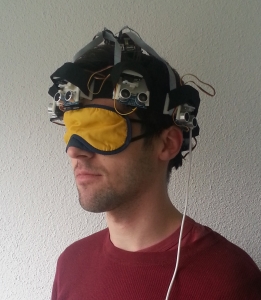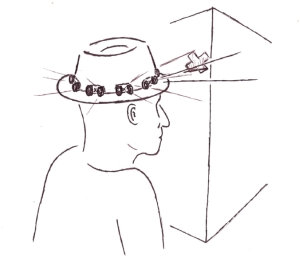Ultrasonic sensors, batteries, and pressure pads are parts of the novel system that can be put on the head like a hat or headband. Decreasing or increasing pressure provides the person wearing the hat with information on the proximity of walls, passages or objects. The system, called proximity hat, measures the surroundings in real time and might help visually impaired persons orient in rooms and firemen find their way around in buildings filled with smoke.
The proximity hat project is aimed at developing a precise aid supplying distance information to users without confusing them as in case of sound signals or vibrations. The new approach applied by architect Florian Braun in his bachelor’s thesis in computer science at the Chair for Pervasive Computing Systems of KIT is based on the perception of pressure. The proximity hat measures the environment by integrated ultrasonic sensors and the user is given information as to how far or near obstacles are located by pressure acting on his head. Six modules accommodate ultrasonic sensors that measure space in all horizontal directions over a range from a few centimeters to several meters. The modules of 5 x 5 cm² in dimension make up to 50 measurements per second. In addition, pads wrapped with elastic plastic are integrated. Their pressure on the head of the user increases with decreasing distance of an obstacle. In this way, collisions can be prevented. During the development period of several months, the proximity hat was tested successfully.
Transmission of information by pressure has hardly been studied so far. “Sensations are enhanced by the proximity hat. It is not only possible to see a space or to hear how it sounds in it. Now, space can also be felt,” Matthias Berning, supervisor of the bachelor’s thesis, says. This pressure feedback might help visually impaired and blind persons find their way around safely and rapidly in their environment. The proximity hat might also be integrated into helmets of firemen for them to orient in rooms filled with smoke. Work of persons laying screeds or technicians working backwards may be facilitated. Compared to other solutions, information by pressure has the advantage of other senses remaining unaffected. According to the author of the thesis, existing systems transmitting the information by sounds or vibrations are often considered uncomfortable, confusing or straining.

The proximity hat. (Photo: KIT)
“So far, seeing and hearing have been in the focus for transmitting digitally measured information to users. Work on the proximity hat shows that information can also be transmitted by pressure,” Professor Michael Beigl, Head of the KIT Chair for Pervasive Computing Systems, says. In his opinion, this perception may also be used in other areas. For example, hazards measured by sensors, such as high air pollution, can be perceived. “We will continue this interesting development work under the Prosperity4All project funded by the EU,” Beigl emphasizes. The project will expire in 2017, the objective being to reduce barriers for people with handicaps by the development of digital products and services.
In close partnership with society, KIT develops solutions for urgent challenges – from climate change, energy transition and sustainable use of natural resources to artificial intelligence, sovereignty and an aging population. As The University in the Helmholtz Association, KIT unites scientific excellence from insight to application-driven research under one roof – and is thus in a unique position to drive this transformation. As a University of Excellence, KIT offers its more than 10,000 employees and 22,800 students outstanding opportunities to shape a sustainable and resilient future. KIT – Science for Impact.

